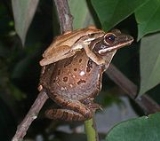
Rhacophoridae
Encyclopedia
Rhacophoridae is a family
of frog
species, which occur in tropical regions of Asia
and Africa
. They are commonly known as shrub frogs, or more ambiguously as '"moss frogs" or "bush frogs". Some Rhacophoridae are called "tree frog
s". Among the most spectacular members of this family are numerous "flying frog
s".
Most of the species
are arboreal and this may include reproducing in trees. Mating frogs, while in amplexus
, hold onto a branch, and beat their legs to form a foam. The eggs are laid in the foam, and covered with seminal fluid, before the foam hardens into a protective casing. In some species, this is done in a large group. The foam is laid above a water source, so the tadpoles fall into the water once they hatch.
The species within this family vary in size, from 1.5 centimetre (0.590551181102362 in) to 12 centimetres (4.7 in). Like other arboreal frogs, they have toe discs, and those of the genus Chiromantis
have two opposable fingers on each hand. This family also contains the Old World flying frog
s, including Wallace's flying frog (Rhacophorus nigropalmatus
). These frogs have extensive webbing between their hands and feet, allowing them to glide through the air.
Family (biology)
In biological classification, family is* a taxonomic rank. Other well-known ranks are life, domain, kingdom, phylum, class, order, genus, and species, with family fitting between order and genus. As for the other well-known ranks, there is the option of an immediately lower rank, indicated by the...
of frog
Frog
Frogs are amphibians in the order Anura , formerly referred to as Salientia . Most frogs are characterized by a short body, webbed digits , protruding eyes and the absence of a tail...
species, which occur in tropical regions of Asia
Asia
Asia is the world's largest and most populous continent, located primarily in the eastern and northern hemispheres. It covers 8.7% of the Earth's total surface area and with approximately 3.879 billion people, it hosts 60% of the world's current human population...
and Africa
Africa
Africa is the world's second largest and second most populous continent, after Asia. At about 30.2 million km² including adjacent islands, it covers 6% of the Earth's total surface area and 20.4% of the total land area...
. They are commonly known as shrub frogs, or more ambiguously as '"moss frogs" or "bush frogs". Some Rhacophoridae are called "tree frog
Tree frog
Hylidae is a wide-ranging family of frogs commonly referred to as "tree frogs and their allies". However, the hylids include a diversity of frog species, many of which do not live in trees, but are terrestrial or semi-aquatic.-Characteristics:...
s". Among the most spectacular members of this family are numerous "flying frog
Flying frog
A "flying" frog is a frog that has the ability to glide. That is, it can descend at an angle of less than 45° relative to the horizontal. Arboreal frogs can also descend vertically, but only at angles greater than 45°, which is referred to as parachuting...
s".
Most of the species
Species
In biology, a species is one of the basic units of biological classification and a taxonomic rank. A species is often defined as a group of organisms capable of interbreeding and producing fertile offspring. While in many cases this definition is adequate, more precise or differing measures are...
are arboreal and this may include reproducing in trees. Mating frogs, while in amplexus
Amplexus
Amplexus is a form of pseudocopulation in which a male amphibian grasps a female with his front legs as part of the mating process...
, hold onto a branch, and beat their legs to form a foam. The eggs are laid in the foam, and covered with seminal fluid, before the foam hardens into a protective casing. In some species, this is done in a large group. The foam is laid above a water source, so the tadpoles fall into the water once they hatch.
The species within this family vary in size, from 1.5 centimetre (0.590551181102362 in) to 12 centimetres (4.7 in). Like other arboreal frogs, they have toe discs, and those of the genus Chiromantis
Chiromantis
Chiromantis is a genus of frogs in the family Rhacophoridae. Most live in the African tropics, but the recently described Chiromantis samkosensis is endemic to Cambodia.-Species:* Chiromantis kelleri Boettger, 1893....
have two opposable fingers on each hand. This family also contains the Old World flying frog
Flying frog
A "flying" frog is a frog that has the ability to glide. That is, it can descend at an angle of less than 45° relative to the horizontal. Arboreal frogs can also descend vertically, but only at angles greater than 45°, which is referred to as parachuting...
s, including Wallace's flying frog (Rhacophorus nigropalmatus
Rhacophorus nigropalmatus
The Abah River Flying Frog , commonly known as Wallace's Flying Frog, is a moss frog found at least from to Malay Peninsula into western Indonesia. It is named for the biologist, Alfred R. Wallace, who collected the first specimen to be formally identified.R. dennysii, R...
). These frogs have extensive webbing between their hands and feet, allowing them to glide through the air.

